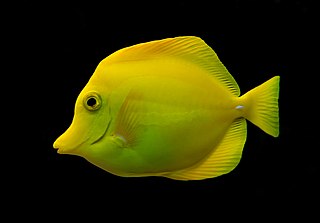
The yellow tang, also known as the lemon sailfin, yellow sailfin tang or somber surgeonfish, is a species of marine ray-finned fish belonging to the family Acanthuridae which includes the surgeonfishes, unicornfishes and tangs. It is one of the most popular marine aquarium fish. It is bright yellow in color, and it lives in reefs. The yellow tang spawn around a full moon. The yellow tang eats algae. The yellow tang has a white barb, located just before the tail fin, to protect itself.

Zebrasoma is a genus of marine ray-finned fishes belonging to the family Acanthuridae which includes the surgeonfishes, unicornfishes and tangs. These fishes are found in the Indo-Pacific region.
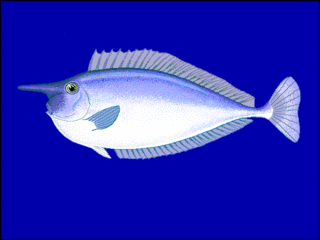
Naso is a genus of marine ray-finned fishes belonging to the family, Acanthuridae, the unicornfishes, surgeonfishes and tangs. The fishes in this genus are known commonly as unicornfishes because of the "rostral protuberance", a hornlike extension of the forehead present in some species. Unicorn fish are popular with spearfishermen and may be cooked by grilling them whole. Unicornfish primarily live around coral reefs and eat mostly algae. It is very popular in Maldives.
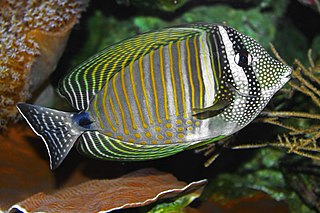
Zebrasoma desjardinii, the Red Sea sailfin tang, Desjardin's sailfin tang, Indian sailfin tang or Indian sailfin surgeonfish, is a species of marine ray-finned fish belonging to the family Acanthuridae which includes the surgeonfishes, unicornfishes and tangs. This fish is found in the Indian Ocean.

Acanthurus triostegus, the convict surgeonfish, convict surgeon, convict tang or fiveband surgeonfish, is a species of marine ray-finned fish belonging to the family Acanthuridae which includes the surgeonfishes, unicornfishes and tangs. This species has a wide Indo-Pacific distribution.

The whitemargin unicornfish, also known as the ringtailed unicornfish or short-horned unicorn-fish, is a tropical fish found throughout the Indo-Pacific. It can reach a length of 100 cm, making it one of the largest members of the family Acanthuridae.
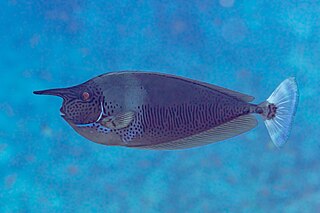
Naso brevirostris, also known as the short-nosed unicornfish, spotted unicornfish, brown unicornfish, lined unicornfish, longnose surgeonfish, palefin unicornfish, paletail unicornfish, shorthorned unicornfish or shortsnouted unicornfish, is a species of marine ray-finned fish belonging to the family Acanthuridae, the surgeonfishes, unicornfishes and tangs. It occurs in the Indian and western Pacific Oceans.
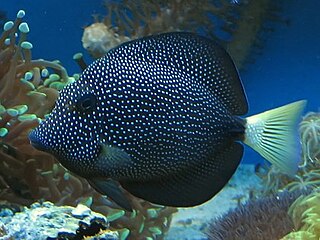
Zebrasoma gemmatum, the gem tang, jewelled tang, spotted tang or Mauritian tang, is a species of marine ray-finned fish belonging to the family Acanthuridae which includes the surgeonfishes, unicornfishes and tangs. This species is found in the Western Indian Ocean. The spotted tang is a highly prized specimen by marine aquarists and often commands high prices.
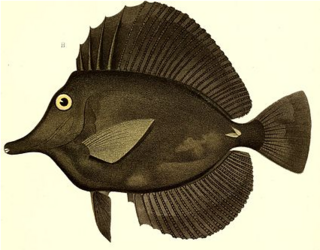
Zebrasoma rostratum, the longnose surgeonfish, longnose tang or black tang, is a species of marine ray-finned fish belonging to the family Acanthuridae, which includes the surgeonfishes, unicornfishes and tangs. This fish is found in the western central Pacific Ocean.

Acanthurus olivaceus, the orange-band surgeonfish, the orange-shoulder surgeonfish or the orangebar tang, is a species of marine ray-finned fish belonging to the family Acanthuridae, this family includes the surgeonfishes, unicornfishes and tangs. It lives in the tropical waters of the Indo-west Pacific.

The sailfin tang, the Pacific sailfin tang, purple sailfinned tang or sailfin surgeonfish, is a marine ray-finned fish belonging to the family Acanthuridae which includes the surgeonfishes, unicornfishes and tangs. This fish is found in the Pacific Ocean and is popular in the aquarium hobby.
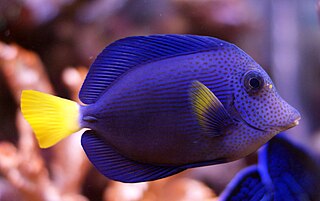
Zebrasoma xanthurum, the purple tang or yellowtail tang, is a species of marine ray-finned fish belonging to the family Acanthuridae which includes the surgeonfishes, unicornfishes and tangs. This species is endemic to the north western Indian Ocean.

Naso lituratus, the clown unicornfish, orangespined unicornfish, black-finned unicornfish, Pacific orangespined unicornfish, blackfinned unicornfish or stripefaced unicornfish, is a species of marine ray-finned fish belonging to the family Acanthuridae, the surgeonfishes, unicornfishes and tangs. This fish is found in the eastern Indian Ocean and western Pacific Ocean.

Acanthurus nigroris, the bluelined surgeonfish, is a species of marine ray-finned fish belonging to the family Acanthuridae, which includes the surgeonfishes, unicornfishes and tangs. This species and A. nigros have been regarded as synonymous with the combined taxon having a wide Indo-Pacific distribution, if treated as a separate valid species it is confined to the United States Pacific islands.
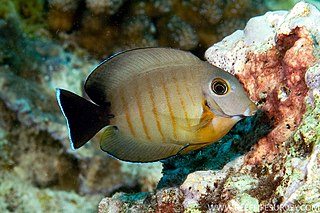
Acanthurus tristis, the Indian Oceam mimic surgeonfish, blackcheek surgeonfish or yellowspot surgeonfish, is a species of marine ray-finned fish belonging to the family Acanthuridae which includes the surgeonfishes, unicornfishes and tangs. This species is found in the eastern Indian Ocean.

Acanthurus maculiceps, the white-freckled surgeonfish, yellow-freckled surgeonfish, pale-lined surgeonfish,spotted-faced surgeonfish or earbar surgeonfish, is a species of marine ray-finned fish belonging to the family Acanthuridae, the surgeonfishes, unicornfishes and tangs. This species is found in the Indo-West Pacific region.
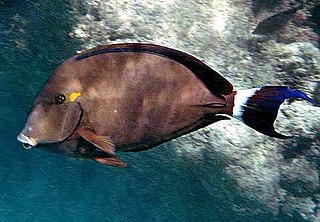
Acanthurus blochii, the ringtail surgeonfish or dark surgeonfish, is a marine ray-finned fish belonging to the family Acanthuridae, the surgeonfishes, unicornfishes and tangs. This fish is found in the Indo-Pacific.
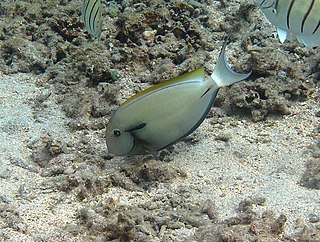
Acanthurus nigricauda, the epaulette surgeonfish, black-barred surgeonfish, eye-line surgeonfish, shoulderbar surgeonfish, white-tail surgeonfish or blackstreak surgeonfish, is a species of marine ray-finned fish belonging to the family Acanthuridae, the surgeonfishes, unicornfishes and tangs. It is native to the Indo-Pacific region.

Ctenochaetus truncatus, the Indian gold-ring bristletooth, squaretail bristletooth, yelloweye bristletooth, truncate bristletooth or spotted yellow eye tang, is a species of marine ray-finned fish belonging to the family Acanthuridae which includes the surgeonfishes, unicornfishes and tangs. This fish is found in the Indian Ocean.
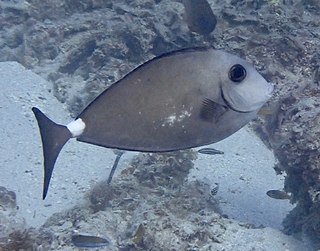
Naso fageni, the horseface unicornfish or blunt unicornfish, is a species of marine ray-finned fish belonging to the family Acanthuridae, the surgeonfishes, unicornfishes and tangs. This fish is found in the Indo-Pacific region.





















